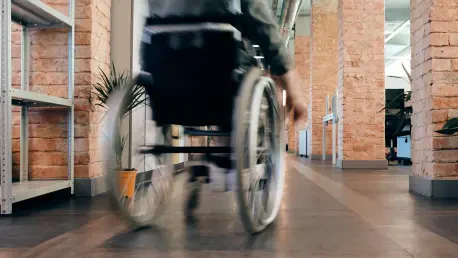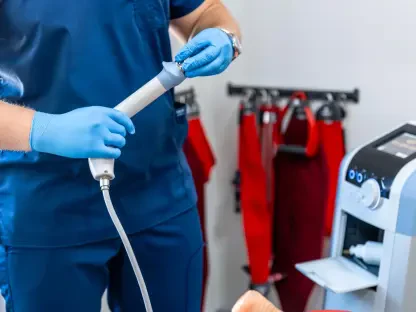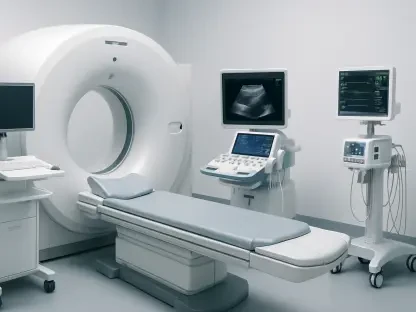Durable medical equipment (DME) encompasses an array of tools and devices integral to modern healthcare, emphasizing repeated use for long-term patient care. These innovative products play a crucial role in transforming patient experiences, especially for those with chronic health conditions, mobility challenges, or limited access to healthcare facilities. By facilitating more efficient, cost-effective, and accessible healthcare solutions, DME redefines how care is delivered both in hospital settings and at home. With the global landscape witnessing a remarkable shift towards home-based care, propelled by an aging population and increasing chronic disease prevalence, durable medical equipment emerges as a pivotal component in enhancing healthcare outcomes. The significance of these devices in revolutionizing patient care stems not only from their functionality but also their alignment with broader healthcare trends focused on patient empowerment and personalized care.
Market Segmentation and Impact
The DME market is segmented based on equipment type, encompassing personal mobility devices, bathroom safety devices, medical furniture, and monitoring and therapeutic appliances. Of these, monitoring and therapeutic equipment lead the charge, driven by heightened demand for in-home monitoring systems tailored to managing respiratory, cardiovascular, and diabetic afflictions. This segment underscores the criticality of equipping patients with tools to oversee their health seamlessly, fostering an environment where immediate intervention is possible. As the geriatric demographic continues to rise, the importance of personal mobility devices grows, offering solutions that enhance mobility and independence. Meanwhile, the classification of DME by end user — spanning hospitals, clinics, ambulatory surgical centers, and home care settings — highlights the expanding role of home care within the healthcare sphere. Patients increasingly opt for at-home recovery and management, preferring comfort, reduced costs, and the ability to recover post-acute care in familiar surroundings. This evolution not only stimulates demand for DME but also catalyzes the industry’s adaptation to meet these evolving needs.
Technological Innovations and Trends
A prevailing trend within the DME sector is the integration of cutting-edge technologies, notably the Internet of Things (IoT) and Artificial Intelligence (AI). These technological advancements revolutionize patient care by facilitating remote monitoring, real-time alerts, and comprehensive usage analytics, making DME increasingly adaptive to individual patient requirements. The customization and ergonomic focus of these devices reflect a growing emphasis on patient-centric solutions, prioritizing comfort and ease while fostering independence. Manufacturers are continually innovating to produce portable, compact products that cater to mobility and travel needs, reflecting a broader demand for adaptable healthcare solutions. Eco-friendly DME manufacturing practices are gaining traction, underscoring a commitment to sustainability and eco-conscious design. As telehealth emerges as a critical component in modern healthcare delivery, its integration with DME highlights the symbiotic relationship between virtual care platforms and physical medical devices. These burgeoning trends not only redefine patient care but also expand the scope of possibilities in healthcare delivery.
Regional Dynamics and Competitive Landscape
The DME market is characterized by varied regional dynamics. North America leads with its advanced healthcare systems and robust insurance frameworks, reflecting a high adoption rate of home healthcare solutions. Europe follows closely, spurred by its aging population and favorable regulatory environment supporting DME expansion. The Asia Pacific region witnesses rapid growth due to demographic shifts, improving healthcare infrastructure, and increasing awareness of chronic disease management. Meanwhile, emerging markets in Latin America, the Middle East, and Africa benefit from medical tourism and investments in healthcare infrastructure. Key industry players, including Stryker Corporation, Baxter International Inc., and Medtronic plc, are at the forefront of innovation. These companies leverage strategic partnerships, engage in acquisitions, and emphasize smart device integration to bolster their market presence. Their focus on enhancing home healthcare solutions aligns with patient-centric care models, reaffirming DME’s role in fostering optimized health outcomes across diverse markets.
Strategic Recommendations and Future Considerations
Despite promising growth, the DME market confronts challenges, including the high costs of advanced products and uneven reimbursement policies across regions. Maintenance complexities and limited awareness about DME options, especially in rural areas, further hinder market penetration. Strategic recommendations for stakeholders emphasize improving affordability and accessibility, particularly in developing regions, and scaling DME compatible with telehealth. Investment in research and development to enhance device efficiency and design can stimulate innovation, while strengthening online distribution channels and home delivery models can enrich patient access to these essential tools. By prioritizing user education through training and robust after-sales support, companies can empower patients and healthcare providers alike, ensuring optimal utilization of DME. Insights from these strategic approaches pave the way for the continuous evolution of DME, marked by technological integration and a focus on sustainable growth.
Conclusion and Next Steps
The Durable Medical Equipment (DME) market is categorized by equipment type, including personal mobility devices, bathroom safety aids, medical furniture, and monitoring and therapeutic appliances. Among these, monitoring and therapeutic devices prevail, with increased demand driven by the need for in-home systems to manage respiratory, cardiovascular, and diabetic conditions. This segment highlights the importance of equipping individuals with tools to seamlessly monitor their health, making timely interventions feasible. With an aging population, the significance of personal mobility devices also grows, providing necessary support for increased independence and movement. Furthermore, the market divides DME by end-user settings like hospitals, clinics, ambulatory surgical centers, and notably, home care environments. There is a noticeable shift toward home-based recovery and management, preferred for the comfort it affords, cost-effectiveness, and familiarity during post-acute care. This trend not only boosts DME demand but also drives industry adaptation to these changing needs.









